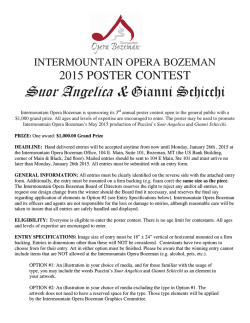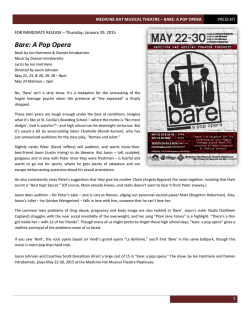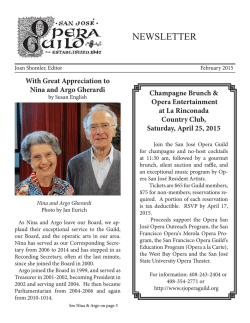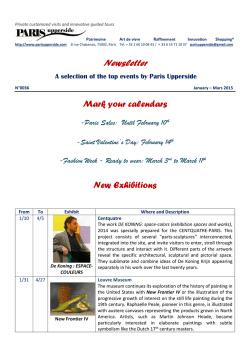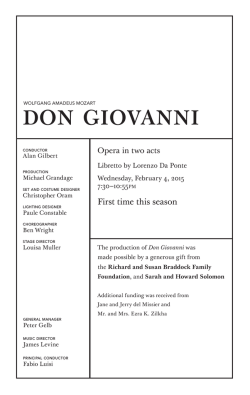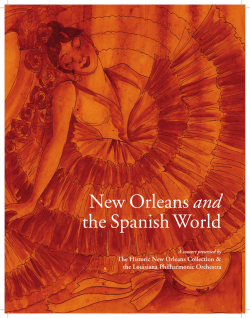
January 28: The Merry Widow
the merry widow FRANZ LEHÁR conductor Paul Nadler production Susan Stroman set designer Julian Crouch costume designer William Ivey Long lighting designer Paule Constable sound designer Operetta in three acts Original libretto by Viktor Léon and Leo Stein based on the play L’Attaché d’Ambassade by Henri Meilhac English version by Jeremy Sams Wednesday, January 28, 2015 7:30–10:15 pm New Production Mark Grey choreographer Susan Stroman The production of The Merry Widow was made possible by a generous gift from The Sybil B. Harrington Endowment Fund general manager Peter Gelb music director James Levine principal conductor Fabio Luisi The 35th Metropolitan Opera performance of the merry widow FRANZ LEHÁR’S co n duc to r Paul Nadler in order of vocal appearance v i co m t e c a s c a da b o g da n ov i tch Jeff Mattsey Mark Schowalter b a r o n m i r ko ze ta n j egu s Sir Thomas Allen Carson Elrod va l en ci en n e h a n n a g l awa r i Kelli O’Hara Renée Fleming s y lv i a n e co u n t da n i lo da n i lov i tch Emalie Savoy* Nathan Gunn* o lg a wo m a n Wallis Giunta* Andrea Coleman pr a s kow i a m aître d’ Margaret Lattimore* Jason Simon c a m i l l e d e r os i l lo n griset tes Alek Shrader lolo r ao u l d e s t. b r i o ch e Alexander Lewis* k r o m ow Daniel Mobbs Synthia Link Alison Mixon joujou Emily Pynenburg froufrou Leah Hofmann cloclo Jenny Laroche margot Catherine Hamilton dodo pr i t s ch i t s ch Gary Simpson Wednesday, January 28, 2015, 7:30–10:15PM KEN HOWARD/METROPOLITAN OPERA Renée Fleming in the title role of Lehár’s The Merry Widow Chorus Master Donald Palumbo Dramaturg Paul Cremo Musical Preparation Thomas Bagwell, Joshua Greene, and Lydia Brown Assistant Stage Directors Daniel Rigazzi and Kathleen Smith Belcher Met Titles Michael Panayos English Coach Erie Mills Assistant Costume Designer Paul Spadone Associate Choreographer Joshua Buscher Assistant Choreographer Lauren Kadel Special Thanks Leah Hofmann Scenery, properties, and electrical props constructed and painted in Metropolitan Opera Shops Costumes executed by Metropolitan Opera Costume Department; Das Gewand GmbH, Düsseldorf; Seams Unlimited, Racine, Wisconsin; and Scafati Theatrical Tailors, New York Director of William Ivey Long’s Studio Donald Sanders Wigs and makeup executed by Metropolitan Opera Wig and Makeup Department Thanks to William Dorwart for his assistance in the preparation of the orchestral material This performance is made possible in part by public funds from the New York State Council on the Arts. The Merry Widow is performed by arrangement with Glocken Verlag, Ltd., publisher and copyright owner. * Graduate of the Lindemann Young Artist Development Program Yamaha is the Official Piano of the Metropolitan Opera. Latecomers will not be admitted during the performance. Visit metopera.org Excerpts from The Merry Widow Ballet, arranged by John Lanchberry, and Jeremy Sams’s English version of “Liebe, du Himmel auf Erden,” from Lehár’s Paganini, are performed by arrangement with European American Music Distributors Company, as agent for and on behalf of Glocken Verlag, Ltd., London, publisher and copyright owner. Before the performance begins, please switch off cell phones and other electronic devices. Met Titles To activate, press the red button to the right of the screen in front of your seat and follow the instructions provided. To turn off the display, press the red button once again. If you have questions please ask an usher at intermission. metopera.org 212.362.6000 Synopsis Paris, 1900 Act I The Pontevedrian Embassy in Paris Intermission (AT APPROXIMATELY 8:20 PM) Act II The garden of Hanna Glawari’s mansion in Paris Act III Chez Maxim Act I The Pontevedrian ambassador in Paris, Baron Mirko Zeta, is giving a ball at the embassy. His home country is nearly bankrupt and he hopes that their Parisian guests will help them raise the money they need. He’s pleased when he sees his young wife, Valencienne, flirting with Camille de Rosillon, a young Frenchman, assuming she’s trying to win French support for Pontevedro. In fact, Camille has declared his love for Valencienne and writes “I love you” on her fan. Zeta eagerly awaits the arrival of the guest of honor, Hanna Glawari, a wealthy Pontevedrian widow. He plans to get Danilo Danilovitch, a womanizing aristocrat and the embassy secretary, to marry her so that her millions will stay in Pontevedro. Hanna arrives and is showered with compliments by the Parisian men. Valencienne realizes she has lost her fan with Camille’s incriminating message and rushes out to look for it. Finally Danilo arrives, fresh from a night of partying at Maxim’s. He and Hanna talk, revealing that they were once in love, but that Hanna was considered too far beneath Danilo’s status for him to marry her. He tells her he’s not interested in marriage and will never say “I love you.” Meanwhile, Zeta’s chief of staff, Kromow, finds Valencienne’s fan and thinks it belongs to his wife, Olga. Zeta, wanting to spare Olga the scandal, convinces him it is Valencienne’s. He then meets with Danilo and orders him to marry Hanna for the good of Pontevedro. Danilo tells him he will keep all the Parisian men away from her, but will not marry her. When the ladies choice dance is announced, Hanna selects Danilo, and after some flirtatious banter the two finally dance. Act II Later that evening, Hanna hosts a party at her villa. Danilo arrives late, and Zeta commands him to return to his mission of keeping the Parisian men from Hanna— particularly Camille. Danilo’s assistant, Njegus, reveals that Camille is already in love with a mystery woman. Zeta wants to know who she is in order to marry her off to Camille, leaving Hanna free for a Pontevedrian suitor. Believing the fan to Visit metopera.org 31 Synopsis CONTINUED be the key to her identity, he asks Danilo to find its owner. When Hanna comes across the fan and sees its inscription, she assumes it is a gift to her from Danilo, but he still won’t say “I love you” and she will not accept him until he does. Their dance is interrupted by Zeta, who is still trying to learn the identity of Camille’s secret lover. The men agree to meet in the pavilion to discuss the matter. Camille and Valencienne finally find the missing fan, and this time Valencienne writes “I am a respectable wife” on it. Observed by Njegus, they disappear into the pavilion. When Zeta arrives to meet Danilo, Njegus prevents him from entering the pavilion to protect Valencienne’s secret and instead sneaks Hanna in to take her place. Hanna emerges with Camille, announcing their engagement. A furious Danilo departs for Maxim’s, which Hanna takes as proof of his love. Act III Arriving at Maxim’s in search of Danilo, Camille and Valencienne sneak off to one of the private rooms. Zeta and the other Pontevedrians appear, and the grisettes—among them a dressed-up Valencienne—entertain the crowd. Eventually both Danilo and Hanna arrive. He forbids her to marry Camille. When she explains that she was merely safeguarding another woman’s reputation, he is delighted but still won’t declare his love. As the guests reassemble, Danilo announces that Hanna will not marry Camille, but he will not reveal the identity of Camille’s secret lover. Njegus produces the missing fan, which he found in the pavilion. Zeta finally recognizes it as his wife’s, declares himself divorced, and proposes to Hanna—who informs him that, according to her late husband’s will, she will lose her fortune if she remarries. At this, the other men lose interest in Hanna, except Danilo, who finally declares his love and asks Hanna to marry him. She accepts and amends her account of the will: upon remarrying her fortune will pass to her new husband. Valencienne asks Zeta to read the other side of her fan—which reads, “I am a respectable wife.” With the couples united, the men are left to wonder about the mystery of women. 32 In Focus Franz Lehár The Merry Widow Premiere: Theater an der Wien, Vienna, 1905 Lehár’s captivating romantic comedy was the biggest success of the composer’s career and, along with Johann Strauss’s Die Fledermaus, represents the most enduringly popular example of the operetta genre. Set in Paris, the story centers on Hanna Glawari, a fabulously wealthy young widow from a fictional Eastern European country and the attempts of its ambassador to find her a new husband in order to keep her fortune in the country and save it from bankruptcy. Mixed in with this are Hanna’s unexpected reunion with a former admirer and the flirtation of the ambassador’s wife with a young Frenchman. The plentiful opportunities for a wide range of romantic and humorous stage magic are obvious, particularly within the operetta format of musical numbers interspersed with spoken dialogue. Several of these numbers are meant to be understood as actual songs performed within the context of the plot, rather than musical expressions of reality (as is common in opera). This creates a plausible world in which emotions can be colorfully expressed in a wide variety of musical forms, including love songs, folk songs, and dance music. Beyond creating a vibrant palette of musical styles, this structure also gives the work a versatility that has appealed to audiences ever since its premiere. The cosmopolitan nature of its story—Austro-Hungarian core with a mythically Parisian ambience and non-specific Balkan characters and music—has also contributed to its global appeal. Lehár’s work can be seen as a crossroads of styles, cultures, and traditions. The early history of the Broadway musical, with its versatility of song style, heavy use of dance and stage spectacle, and direct popular appeal to a large audience, is massively indebted to operetta in general and to The Merry Widow in particular. The Creators Franz Lehár (1870–1948), born Lehár Ferenc in Komárom, Austria-Hungary (now part of Slovakia), trained at the Prague Conservatory, where his mentors included Antonín Dvoˇrák. He wrote some orchestral music but is remembered primarily for his operettas, especially The Merry Widow (Die Lustige Witwe), his breakthrough success, and The Land of Smiles (Das Land des Lächelns, 1929, with the hit song “Dein ist mein ganzes Herz”). The libretto to The Merry Widow was written by the Vienna-based team of Leo Stein (1861–1921) and Viktor Léon (1858–1940), who also collaborated on libretti for Johann Strauss, Jr., and others. Visit metopera.org 33 In Focus CONTINUED The Setting The Merry Widow takes place amid the vibrant artistic, diplomatic, and social worlds of Paris in the early 20th century and in the expatriate community of Pontevedro, a fictional Balkan country that bears some resemblance to Montenegro. The Music The score of The Merry Widow is charming and melodious but also highly sophisticated. Various types of dance music permeate the operetta, providing an opportunity for delightful visuals on stage while at the same time creating an atmosphere of refined giddiness that is central to the story. Hanna makes her entrance singing a mazurka, a Polish folk dance in triple time. Other dance music, with or without vocals, includes a waltz in the Act I finale, “Pontevedrian” dances for the opening of Act II, idealized cabaret music in the Act III party scene, and, most famously, Hanna and Danilo’s duet in the final scene (popularly known as the “Merry Widow Waltz”). Among the vocal numbers, Hanna’s lithe, slightly melancholy, and utterly ravishing “Vilja Song” in Act II stands out. Danilo’s brief entrance aria is witty and urbane, and Camille and Valencienne share a teasing duet in Act I—there is something not quite dangerous about their flirtation at this point, although it becomes much more serious with Camille’s ardent love aria in Act II. The orchestral writing ranges from the grand to the elegant to surprisingly delicate touches like the intertwining cello and violin lines representing Danilo and Hanna in their waltz duet, telling the audience what the characters hardly dare to express themselves. The Merry Widow at the Met Lehár’s operetta premiered at the Met in February 2000, in an English-language production by Tim Albery with designs by Antony McDonald. Sir Andrew Davis conducted a cast led by Frederica von Stade, Plácido Domingo, John Del Carlo, Paul Groves, and Emily Pulley. Håkan Hagegård also appeared in the role of Danilo (which has traditionally been sung by both tenors and baritones) for five performances in the initial run. For a revival in 2003, Susan Graham took on the title role and Bo Skovhus sang Danilo. Conductors Asher Fisch (2000) and Kirill Petrenko (2003) both made their Met debuts with this work. Susan Stroman’s new production, starring Renée Fleming, Kelli O’Hara, and Nathan Gunn, opened on New Year’s Eve 2014, again with Davis on the podium. 34 Program Note T he fin de siècle was an exciting but tense time. In Vienna, the political world took a swing to the right, with increased anti-Semitism stoked by a divisive mayor. Simultaneously (and arguably consequently), liberal figures such as Freud, Klimt, Loos, Mahler, Schnitzler, and Schoenberg were on the rise, trying to scrape away the pretentious pomp and circumstance that had dominated Imperial Vienna for centuries. The battle lines were, in effect, drawn. So it was little wonder that the rest of Vienna was in desperate need of a bit of escapism. And with the death of Johann Strauss, Jr. in 1899, Viennese operetta was missing one of its guiding lights. But then, in 1905, Franz Lehár sparked a brand new era with the premiere of The Merry Widow. Operetta had provided a musical panacea for the Viennese since the late 1850s, when Offenbach’s opéras bouffes dominated the city’s playbills. The adopted Frenchman’s monopoly on the art form in Austria remained more or less unchallenged until 1874, when Strauss’s Die Fledermaus burst onto the scene. Coming immediately after the financial crash of 1873, whose effects caused much of the strain of the fin de siècle, that masterpiece’s blithe maxim, “Happy is he who forgets what cannot be changed,” became a regular Viennese slogan. Indeed, every night of the week, the city’s operetta houses, the Carltheater and the Theater an der Wien, were packed to the rafters with audiences desperate to forget the recession and resulting remonstrations. Eventually, composer Richard Heuberger and librettist Victor Léon stole Strauss’s limelight with Der Opernball in 1898. Keen to repeat the triumph, Léon (a journalist born in present-day Slovakia) and his writing partner, Leo Stein (a playwright from Lemberg, now Lviv in Ukraine), handed a new libretto to Heuberger. It was based on L’Attaché d’Ambassade, a play by Henri Meilhac. Together with Ludovic Halévy, Meilhac had written many of Offenbach’s hits, as well as the text for Carmen in 1875 and for Le Réveillon, the basis for Die Fledermaus. Sadly, these theatrical feats didn’t seem destined for a reprise when Heuberger delivered his score, which was promptly rejected by the Theater an der Wien. A new composer had to be found and, after a swift search, the writers daringly plumped for a young Hungarian called Franz Lehár. Writing The Merry Widow, as it came to be known, was something of a homecoming for Lehár. His father had played the horn in the orchestra at the Theater an der Wien, before becoming a military bandmaster. Franz Jr. was born in 1870 in the Hungarian garrison town of Komárom. When his father was posted to a new role in Budapest, Lehár was sent to stay with an uncle in what is now the Czech Republic and eventually attended the Prague Conservatory, studying composition privately with Zdenck ˇ Fibich, as well as receiving valuable advice from Dvořák. After graduation and a brief stint as a theatrical violinist, Lehár joined his father’s 50th Austrian Infantry Regiment. He was made a bandmaster in 1890 but gave up that position to prepare for the premiere of his first opera, Visit metopera.org 35 Program Note CONTINUED Kukuška, in Leipzig in 1896. Its out-and-out failure brought him back to military life, with posts in Budapest and, eventually, Vienna. Although his first stage work had been a flop, Lehár was achieving some success with his dance music, not least the infectious waltz Gold und Silber. And so he again left military service, becoming a conductor at the summer theater in the Prater amusement park and then moving to the Theater an der Wien. Courageously playing his bosses against their rivals at the Carltheater, Lehár had one operetta, Wiener Frauen, produced at the Theater an der Wien in November 1902, with Der Rastelbinder following a month later at the Carl. The gamble paid off and, although his two subsequent stage works in 1904 were failures, his employers kept faith. The Theater an der Wien’s convictions were soon rewarded. The opening night of The Merry Widow on December 30, 1905—capping a musical year in which Richard Strauss’s Salome, Mahler’s Kindertotenlieder, Schoenberg’s Pelleas und Melisande, and Debussy’s La Mer had their premieres—marked the beginning of the “Silver Age” of operetta and established Lehár’s predominance in the genre. The show was soon being performed on tour in Austria, before enjoying productions in Berlin, Hamburg, and Budapest in 1906 and in London and New York in 1907. Ever since, it has been one of the most cherished operettas of all time. The triumph of The Merry Widow undoubtedly stems from its ravishing score and its particularly colorful response to the story’s happy clash of Parisians and Pontevedrians. While satire is part and parcel of Léon and Stein’s synopsis, Lehár’s evocations of “the city of light” and of Pontevedrian (or Balkan) traditions are affectionate and often admirably authentic—Lehár even employs a bouzouki or mandolin-type instrument, the tamburizza, to accompany Hanna’s “Vilja Song.” But this dose of local color would be nothing without the composer’s melodic gift. Like Strauss’s operettas before it, The Merry Widow is a veritable smorgasbord of tunes. And yet, echoing the era in which Lehár was writing, his songs and arias have a richer harmonic vein. Their beautifully winding melodies, juxtaposed with the ceremonial music of the ambassador’s soirées and the high jinks of Hanna’s party, introduce one of the defining elements of Silver Age operettas: sex. Though eroticism had certainly been part of the preceding Golden Age—Die Fledermaus is, after all, about various infidelities—it was now treated with greater sensuality, revealing a more acute realism (as well as parallels with the work of Lehár’s more noticeably “serious” cultural peers). The violin and cello melodies that intertwine in Hanna and Danilo’s duet Act III, “Music’s Playing” (“Lippen schweigen”) offer just one highlight of Lehár’s attention to emotional detail. Indeed, this waltz alone could mark the transition between the operettas of the 19th century and those of the 20th, of which Lehár was the herald. Rather than being energetic dance pieces, these new waltzes sway and swoon. 36 Such musical perspicacity is part of the interaction of the characters. The inclusion of a younger couple, Valencienne and Camille, may follow generic standards, but Lehár and his librettists clearly intended the pair’s romance to be a source of genuine jeopardy. Their dialogue has a skittish quality at first, but a supplementing vein of chromaticism belies their innocence. Camille’s claim that he loves only Valencienne is particularly ardent and she soon capitulates, joining him in their first duet. In Act II, however, their music takes on an even more passionate tone (enhanced by Lehár’s expanded orchestral forces), with unforeseen Wagnerian traces. Despite the rich characterization of this charming pair, there can be no doubt that Lehár wants our affections and attentions to rest with Hanna and Danilo. Both are accorded winning entrance numbers: Hanna’s “If I Was a Parisian” (“Hab’ in Paris”), with its thrilling opening crescendo over a timpani roll, and Danilo’s “As Diplomatic Attaché” (“O Vaterland”). The latter’s refrain, “Then off to Chez Maxim,” returns at the conclusion to Act II, when in spite of Danilo’s anger at Hanna’s supposed love for Camille—she has also successfully duped Baron Zeta—the orchestra reveals the truth of the matter: Danilo may be strutting off to Maxim’s, but his heart is with Hanna (as she well knows). And with Hanna’s love for dancing, infectious tunes, and unswerving capacity for compassion, it is little wonder that Danilo is so smitten with her—and that so many sopranos and mezzo-sopranos have cherished playing the role. The Merry Widow has continued to beguile performers and audiences alike for more than a century. After its premiere in 1905, Lehár came to enjoy an almost unparalleled career as an operetta composer—his rivalry with fellow Hungarian Emmerich Kálmán was the genre’s primary catalyst in the first half of the 20th century. Perhaps the only misfortune of this operetta’s success is its tendency to overshadow Lehár’s other inspired works for the stage. After all, each of those no less tuneful, no less true operas and operettas—just like his friend Puccini’s La Rondine (originally intended for Vienna) or the romantic musicals of Broadway’s Golden Age—are thoroughly indebted to the melodic and emotional acuity of The Merry Widow. —Gavin Plumley Visit metopera.org 37 The Cast and Creative Team Paul Nadler conductor (chicago, illinois) The Merry Widow and Ernani at the Met. Die Fledermaus, Rusalka, Roméo et Juliette, Eugene Onegin, Die Zauberflöte, Fidelio, Un Ballo in Maschera, Il Barbiere di Siviglia, Tannhäuser, Aida, Don Carlo, Andrea Chénier, La Traviata, Carmen, Le Rossignol, Le Sacre du Printemps, Oedipus Rex, Eugene Onegin, and Rigoletto (debut, 1989). career highlights Recent seasons include Turandot, Tosca, Le Nozze di Figaro, and Così fan tutte in Montreal, Salome for Opera Cleveland, Carmen and Don Giovanni for the National Opera of Bucharest, and Il Barbiere di Siviglia, Tosca and Faust at Opera Naples. He has also conducted at Indianapolis Opera, Utah Opera, Calgary Opera, Florentine Opera, Minnesota Opera, Syracuse Opera, Orlando Opera, and Hong Kong Opera. Concert work includes appearances with the Orquestra de Navarra, Israel Chamber Orchestra, Verbier Festival, Augsburg Symphony, Orchestra Sinfonica Siciliana, Florida Philharmonic Orchestra, Romanian National Radio Orchestra, and Brasov and Iasi Orchestras. He is co-director/founder of the International Vocal Arts Institute and in 1974 founded the Cincinnati Chamber Orchestra. this season met appearances Jeremy Sams librettist (london, england) English version of The Merry Widow at the Met. Director (debut, 2013) and lyricist for Die Fledermaus and librettist for The Enchanted Island. career highlights He is a writer, translator, orchestrator, musical director, film composer, and lyricist. Directing credits include The Wizard of Oz (West End and Toronto), Educating Rita (West End), The Sound of Music (West End and Toronto), 13 (Broadway), Little Britain (London and UK tour), Noises Off (Royal National Theatre and Broadway), Passion, Wild Oats, Marat/Sade, Enter the Guardsman, The Wind in the Willows, Spend Spend Spend, Benefactors, and Two Pianos, Four Hands. He received a Tony nomination for his lyrics to the musical Amour and has done translations of Indiscretions, The Miser, and Mary Stuart for the Royal National Theatre; The Rehearsal, Beckett, Figaro’s Wedding, La Bohème, The Magic Flute, and Wagner’s Ring cycle for English National Opera; and The Merry Widow for Covent Garden. He composed music for The Wind in the Willows, Arcadia, and The Merry Wives of Windsor, and wrote the book for the stage version of Chitty Chitty Bang Bang (West End and Broadway). this season met productions Susan Stroman director and choreographer (wilmington, delaware) The Merry Widow for her debut at the Met. A five-time Tony Award-winning Broadway director and choreographer, she has also been honored with Olivier, Drama Desk, Outer Critic Circle, Astaire, and Lucille Lortel Awards. Most this season career highlights 38 recently she directed and choreographed the world premiere of Little Dancer at the Kennedy Center. She directed and choreographed The Producers, winner of a record-making 12 Tony Awards, including Best Direction and Best Choreography. She directed and choreographed The Scottsboro Boys on Broadway, London’s West End, and in major regional theaters across the country and co-created, directed, and choreographed the musical Contact for Lincoln Center Theater. Other Broadway credits include Bullets Over Broadway, Big Fish, Young Frankenstein, The Frogs, Oklahoma!, Thou Shalt Not, The Music Man, Steel Pier, Show Boat, and Crazy for You. Off-Broadway credits include Happiness, And the World Goes ’Round, and Flora the Red Menace. For New York City Opera she choreographed A Little Night Music, 110 in the Shade, and Don Giovanni. For New York City Ballet she created Double Feature, a full-length ballet set to the music of Irving Berlin and Walter Donaldson, and For the Love of Duke, featuring the music of Duke Ellington. She also created the ballets But Not For Me for the Martha Graham Company and Take Five…More or Less for Pacific Northwest Ballet. She received the American Choreography Award for her work in the Columbia Pictures feature film Center Stage. She is a recipient of the George Abbott Award for Lifetime Achievement in the American Theater and this year will be inducted into the Theater Hall of Fame. Julian Crouch set designer (keighley, england) this season The Merry Widow at the Met and Hedwig and the Angry Inch (Tony Award nomination) on Broadway. met productions Associate director and set designer for Satyagraha (debut, 2008), The Enchanted Island, and the 125th Anniversary Gala; and set designer for Doctor Atomic. career highlights Among his recent productions are Big Fish and The Addams Family on Broadway, Cinderella for the Dutch National Ballet, and The Magic Flute for Welsh National Opera. He is a director, designer, writer, and teacher whose career has spanned theater, opera, film, and television. In 1992 he began a creative partnership with Phelim McDermott, and their most enduring collaboration to date has been the award-winning Shockheaded Peter for Cultural Industry. With Lee Simpson and Nick Sweeting, he and McDermott formed the theater company Improbable in 1996. Their productions of 70 Hill Lane, Sticky, and The Devil and Mr. Punch have gained international recognition. Recently, he was designer on Jerry Springer: The Opera, A Funny Thing Happened on the Way to the Forum (London’s National Theatre), and The Magic Flute (Welsh National Opera). William Ivey Long costume designer (seaboard, north carolina ) The Merry Widow for his debut at the Met. He is currently represented on Broadway by Cabaret, and Chicago (now in its 19th year). For the opera stage he has designed Bernstein’s A Quiet Place (the world premiere at Houston Grand Opera and subsequently at the Vienna State Opera and La Scala); Postcard from Morocco (Kennedy Center); Wozzeck (Welsh National Opera); and Die Entführung aus this season career highlights Visit metopera.org 39 The Cast and Creative Team CONTINUED dem Serail (San Francisco Opera). He is a frequent collaborator of Susan Stroman, most recently designing costumes for her productions of Little Dancer (Kennedy Center) and Bullets Over Broadway (Broadway’s St. James Theatre). Upcoming Broadway projects include On the Twentieth Century and It Shoulda Been You. He is the recipient of six Tony Awards (having been nominated 14 times), was inducted into the Theatre Hall of Fame in 2005, and Chairman of the American Theatre Wing in 2012. Paule Constable lighting designer (brighton, england) this season New productions of Le Nozze di Figaro, The Merry Widow, and Cavalleria Rusticana and Pagliacci and the revival of Don Giovanni at the Met and The Curious Incident of the Dog in the Night-Time, The Cripple of Inishmaan, and Les Mis on Broadway. met productions Satyagraha (debut, 2008), Giulio Cesare, and Anna Bolena. career highlights She received the 2011 Tony Award for the Broadway production of War Horse and received Olivier Awards in the UK for The Curious Incident of the Dog in the Night-Time and His Dark Materials at the National Theatre, Don Carlos at London’s Gielgud Theatre, and The Chalk Garden at the Donmar Warehouse. Operatic engagements include Carmen, Faust, Rigoletto, Die Zauberflöte, and Macbeth for Covent Garden; Die Meistersinger von Nürnberg, Billy Budd, Carmen, La Bohème, and Rusalka at Glyndebourne; Idomeneo, Satyagraha, and Peter Grimes for English National Opera; and Monteverdi’s L’Incoronazione di Poppea, Semele, and Agrippina for Paris’s Théâtre des Champs-Élysées. She recently designed lighting for David McVicar’s productions of Wagner’s Ring cycle in Strasbourg and Tristan und Isolde in Tokyo. Mark Grey sound designer (vienna , austria ) The Death of Klinghoffer, The Merry Widow, Iolanta, and Bluebeard’s Castle at the Met. met production Doctor Atomic (debut, 2008). career highlights Recent projects include sound design for Weinberg’s The Passenger for Houston Grand Opera and Lincoln Center Festival, Oklahoma! and The Sound of Music for Lyric Opera of Chicago, and Adams’s El Niño and The Gospel Acording to the Other Mary. He also designed sound for The Death of Klinghoffer for his debut at English National Opera, The Bonesetter’s Daughter at the San Francisco Opera, and (as sound designer and artistic collaborator) for Adams’s On the Transmigration of Souls. Additional performances include works at Avery Fisher Hall, Carnegie Hall, London’s Royal Albert Hall and Barbican Centre, Sydney Opera House Concert Hall, and Amsterdam’s Concertgebouw. He designed the sound for the world premiere of Doctor Atomic at the San Francisco Opera in 2005. He made his Carnegie Hall debut as a composer in 2003, and has been commissioned by Brussels’s La Monnaie to write an opera based on Mary Shelley’s Frankenstein, scheduled to premiere in spring 2016. this season 40 Renée Fleming soprano (rochester , new york ) Hanna Glawari in The Merry Widow at the Met, the Countess in Capriccio in Dresden and Chicago, Raquel de Angelis in the play Living on Love at the Williamstown Theater Festival, a recital tour of the U.S., and concerts in Dresden, Berlin, Chicago, San Antonio, New York, and Minneapolis. met appearances Title roles of Rusalka, Rodelinda, Armida, Thaïs, Manon, Arabella, and Susannah, Desdemona in Otello, the Marschallin in Der Rosenkavalier, Violetta in La Traviata, Tatiana in Eugene Onegin, the Countess in Le Nozze di Figaro (debut, 1991) and Capriccio, Donna Anna in Don Giovanni, Rosina in the world premiere of Corigliano’s The Ghosts of Versailles, Imogene in Il Pirata, Ellen Orford in Peter Grimes, Fiordiligi in Così fan tutte, Pamina in Die Zauberflöte, and Marguerite in Faust. career highlights She has appeared in all the world’s leading opera houses, is a recipient of the National Medal of Arts and of four Grammy Awards, and was awarded the titles of Chevalier de la Légion d’Honneur and Commandeur de l’Ordre des Arts et des Lettres by the French government. She was a 1988 winner of the Met’s National Council Auditions and is currently Creative Consultant for Lyric Opera of Chicago. this season Kelli O’Hara soprano (elk city, oklahoma ) Valencienne in The Merry Widow for her debut at the Met, Mrs. Darling in ABC’s live telecast of Peter Pan, and Anna in Lincoln Center Theatre’s Broadway production of The King and I. career highlights She has been nominated for Tony Awards for her performances in The Bridges of Madison County, South Pacific, The Pajama Game, The Light in the Piazza, and Nice Work If You Can Get It. Additional work on Broadway includes Jekyll & Hyde, Follies, Sweet Smell of Success, and Dracula. She has also sung Julie Jordan in Carousel and Eliza Doolittle in My Fair Lady with the New York Philharmonic, appeared in productions of Far From Heaven at the Williamstown Theatre Festival and at Playwrights Horizons, King Lear at the Public Theater, Bells Are Ringing at City Center Encores!, Ricky Ian Gordon’s My Life with Albertine at Playwrights Horizons, and appeared in solo shows at Carnegie Hall and Town Hall as well as in Gilbert and Sullivan’s The Mikado at Carnegie Hall. Her television credits include Blue Bloods, All Rise, Alexander Hamilton, All My Children, and the animated series Car Talk; her film credits include Sex and the City 2. this season Sir Thomas Allen baritone (seaham, england) Baron Mirko Zeta in The Merry Widow at the Met and Prosdocimo in Il Turco in Italia at Covent Garden. met appearances The Music Master in Ariadne auf Naxos, Faninal in Der Rosenkavalier, Beckmesser in Die Meistersinger von this season Visit metopera.org 41 The Cast and Creative Team CONTINUED Nürnberg, Count Almaviva in Le Nozze di Figaro, Don Alfonso in Così fan tutte, the Seven Nemeses in Death in Venice, Eisenstein in Die Fledermaus, Figaro in Il Barbiere di Siviglia, Sharpless in Madama Butterfly, Billy Budd, and Papageno in Die Zauberflöte (debut, 1981). career highlights A frequent guest at all the world’s leading opera houses, he has been particularly associated with London’s Royal Opera House, where he has sung more than 40 roles. He made his directing debut in 2003 with Britten’s Albert Herring at London’s Royal College of Music, followed by Così fan tutte at Boston Lyric Opera, Don Pasquale at Lyric Opera of Chicago, Le Nozze di Figaro for Arizona Opera, and Il Barbiere di Siviglia, Le Nozze di Figaro, Die Zauberflöte, and Don Giovanni for Scottish Opera. Nathan Gunn baritone (south bend, indiana ) this season Danilo in The Merry Widow at the Met, Zurga in Les Pêcheurs de Perles at the Theater an der Wien, and the title role of Sondheim’s Sweeney Todd at the Houston Grand Opera. met appearances Over 100 performances of 14 roles, including the title role of Billy Budd, Papageno in Die Zauberflöte, Raimbaud in Le Comte Ory, Clyde Griffiths in the world premiere of Picker’s An American Tragedy, Guglielmo in Così fan tutte, and in the ensemble of Corigliano’s The Ghosts of Versailles (debut, 1995). career highlights He created a number of roles in world premieres, including James Dalton in Iain Bell’s A Harlot’s Progress at the Theater an der Wien, Yeshua in Mark Adamo’s The Gospel of Mary Magdalene at the San Francisco Opera, Alec Harvey in Previn’s Brief Encounter at the Houston Grand Opera, Father Delura in Peter Eötvös’s Love and Other Demons at Glyndebourne, and Paul in Daron Hagen’s Amelia at the Seattle Opera. He is a graduate of the Met’s Lindemann Young Artist Development Program, a recipient of the Met’s Beverly Sills Artist Award, and was recently named Director of the American Repertoire Council at the Opera Company of Philadelphia. Alek Shrader tenor (cleveland, ohio) Camille de Rosillion in The Merry Widow at the Met, Emilio in Handel’s Partenope with the San Francisco Opera, Jupiter/Apollo in Handel’s Semele with the Seattle Opera, Count Almaviva in Il Barbiere di Siviglia with the Canadian Opera Company, Tonio in La Fille du Régiment with Santa Fe Opera, and the title role of Candide in concert with the Vancouver Symphony. met appearances Tamino in The Magic Flute, Ferdinand in The Tempest (debut, 2012), and Count Almaviva in The Barber of Seville. career highlights Recent performances include Ernesto in Don Pasquale at the Santa Fe Opera and Count Almaviva at the San Francisco Opera, Lyric Opera of Chicago, and Dallas Opera. He has also sung Don Ramiro in La Cenerentola in Hamburg, Ernesto in Don Pasquale at the Glyndebourne Festival, Tom Rakewell in The Rake’s Progress in Lille, Tamino with Lyric Opera of Chicago and San Francisco Opera, and the title role of Britten’s Albert Herring with the Los Angeles Opera and Santa Fe Opera. He was a 2007 winner of the Met’s National Council Auditions. this season
© Copyright 2024
